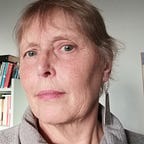My latest way into meditation
Inspiration from the Cloud of Unknowing
Whether we are religious in any sense or not, the benefits of incorporating meditation into our lives are many. In our fast-paced world, just taking time to be with ourselves in quiet is a plus. Our brains are grateful for the chance to rest from processing new information. Our nervous systems welcome some down time, to re-establish equilibrium. Our bodies have often racked up a rest deficit and relish a period of inactivity.
Of course, meditation is much more than that, especially for those who use it as an opportunity to commune with God, however God is understood: as a loving personal Presence or as the Ground of all Being. However we approach meditation, we soon find that being physically still does not mean that our minds stop working. In fact, removing ourselves from outer stimulation, we find ourselves suddenly more aware of the constant activity of the mind. Reliving recent (or long past) conversations and events, looking ahead to the rest of our day, wrestling with unresolved problems, daydreaming, worrying around ‘what if’ scenarios.
This is when we realize that true meditation is not just taking time to sit in quiet. It is both more elusive and more profound. It is about finding our way into a different state of consciousness, where the usual activity of the mind takes a back seat and we access, however briefly and intermittently, a larger, more spacious place. For those of us who pray, we know the difference between reciting our mind-based requests and coming to rest in a wordless communion with God.
In this more spacious state of consciousness, fears and preoccupations recede amid a sense that everything has its place and all is ultimately well. It is from this place that creative insights seem to pop up and serendipitous happenings become more frequent. We hear God speak to us, as it were.
But how to shift from our usual mind activity to the spacious place of meditation or true prayer? Throughout history, humans have been led to or have happened upon different ways to access this place. It has been understood in different ways at different times. But those who have written about meditation over the centuries, whether from a religious standpoint or not, have all described the obstacles to resting in this more spacious consciousness. During the time of meditation or prayer, ever-recurrent thoughts have to be gently let go, again and again. Thoughts and feelings have to be understood as clouds passing through the spacious sky, which do not have to be given attention.
One method for keeping the mind from latching on to the thoughts and feelings that arise is to use a mantra or a prayer word. By gently and silently repeating the word — something as simple as Love or God or Peace — we give our minds something to hold on to while we relax into Being rather than thinking. When we find (as we will) that we have latched onto a particular thought, all we need to do is gently return to the word.
What I find works for me is something recommended in many meditation traditions, including the ancient Christian approach to contemplation: that of following the breath. We breathe automatically, whether we are thinking about breathing or not. By simply noticing the breath flowing into and out of our bodies, our attention is drawn away from thinking. In addition to following the breath, I also give attention to what Eckhart Tolle calls ‘the life of the inner body.’ When I was a teenager in the early 1970s and involved in the charismatic movement in the Christian church, a friend prayed for me to be ‘filled with the Holy Spirit.’ Together with a sense of Presence I became aware of a pleasant tingling sensation, particularly in my hands. Over the years my understanding of the Spirit, of Being, has expanded, such that I now see every human being (indeed every creature and even what seem to us to be inanimate ‘things’) as being grounded in God. That without the animating Spirit, nothing would exist. For the most part, people live unaware of their own essence, which is spiritual, knowing themselves only in the more immediate reality of their bodily and psychological selves.
So in coming to meditation or prayer, I focus my attention on my breathing and also the tingling in my hands which speaks of the inner, spiritual life. But the restless ‘monkey mind,’ as Buddhism describes it, is very persistent, and I find thoughts can still distract me. More recently, I have taken inspiration from the fourteenth-century Christian writer known only as the author of ‘The Cloud of Unknowing’ and other writings on prayer. He talks about the need for the would-be contemplative to have a ‘cloud’ or a ‘darkness’ between ourselves and God. He writes, ‘by darkness I mean a lack of knowing.’ How do we ‘know’ anything? By learning, by thinking, by judging, by remembering: all functions of the mind. The ‘Cloud’ Author is pointing to the need to come out of the thinking mind in order to ‘know’ God and reality from a deeper part of our being.
Although the medieval writer is not talking about a literal cloud, I have found it helpful to take inspiration from the metaphor he uses. Along with noticing the breath and feeling the inner life of the body, I like to hold in my mind’s eye the image of a sky that is covered in cloud. There is something about the immensity of a cloudy sky, its seemingly limitless nature, and the lack of distinguishing features, that speaks to me of the ‘emptiness’ the Buddha spoke about, that is paradoxically also the ‘fullness of life’ of which Jesus spoke. The larger, the deeper, underlying Reality which we may call God and which meditation and prayer help us to enter into.
